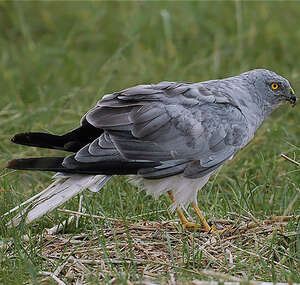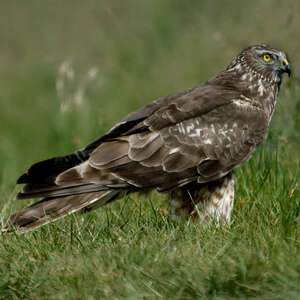Hen Harrier
Circus cyaneus - Busard Saint-Martin
Identification
The Hen Harrier is part of a group of Harriers referred to as grizzly due to the color of its male plumage. In the western Palearctic region, there are three grizzly harriers, including the Hen Harrier, the Common (or Grey) Harrier, and the Pallid Harrier, whose female and immature plumage can create real identification problems. In fact, harriers are highly sexually dimorphic. For the three mentioned here, the males have a grey back with black tips on the wings and the females have a discreet, streaked brown plumage for nesting safety. When perched, the adult male Hen Harrier appears to be uniformly grey-ash, except for the black wing tips and the lighter tail. The underside is white, except for the grey chest. The eyes, nostrils of the bill and legs are a bright yellow. In flight, it can already be recognized by its silhouette; it is the largest of the three. It has wide wings, with five black fingers at the hand and a marked black border on the edge of flight due to the black tips of the remiges. The tail, of medium length, is light and often vaguely barred. From above, the white rump is well visible. The adult female is entirely brown on the upper parts, not uniform brown, but with pale areas, especially on the head, neck and on the wing covers. The head shows a pale face with a dark spot in front of the eye and light eyebrows. At the back of the covers, a kind of light collar, like a pearl necklace, is more or less visible depending on the individuals. The underside is off-white or reddish with many brown stripes on the neck and chest, continuing more finely and fewer on the belly and up to the under tail coverts. In flight, the silhouette is also distinctive, even more massive than that of the male, with also five fingers at the hand.The white rump is broad and striking. The underwing shows pale primaries heavily barred with brown. At the carpal, the dark brown postsecondaries form, along with the dark brown spots on the secondaries, a dark area contrasting with the pale hand. The pale tail is barred with blackish-brown. Iris, wax and legs as the male. The juvenile is of a darker and more uniform brown on top, with reddish spots on the coverts. Its head is dark brown with the forehead, throat, eyebrow, an area under the eye and the pale collar more marked. The underside looks very red. In flight, the white rump stands out clearly against its brown background and the tail is well barred. The underside is like that of the female, but with the neck darker, the body well reddish and the dark area at the wrist darker and more contrasting. Finally, let us remember the specific diagnostic criterion: 5 fingers at the hand (4 in the ash-gray and the pale one).
Subspecific information monotypic species
Foreign names
- Busard Saint-Martin,
- Aguilucho pálido,
- tartaranhão-cinzento-eurasiático,
- Kornweihe,
- kékes rétihéja,
- Blauwe Kiekendief,
- Albanella reale,
- blå kärrhök,
- Myrhauk,
- kaňa sivá,
- moták pilich,
- Blå Kærhøg,
- sinisuohaukka,
- arpella pàl·lida comuna,
- Bláheiðir,
- błotniak zbożowy,
- lauku lija,
- pepelasti lunj,
- Полевой лунь,
- ハイイロチュウヒ,
- 白尾鹞,
- เหยี่ยวทุ่งแถบเหนือ,
- 灰澤鵟〔白尾鷂,北方灰鷂〕,
Voice song and call
The contact call is a short, whistled hiiij. The female that alarms near the nest emits a rapid ke ke ke ke ke... as long as the danger persists. It is a rather close, modulated cry that is issued during the parade ka ka ka ka ka.... The begging calls of the young are persistent piiiih piiiih.... Outside the breeding season, the bird is rather quiet. Some cries can be heard near the inter-nuptial night roosts.
Habitat
The Hen Harrier is a species of open or semi-open areas, typically with a thick grassy layer and a sparse bush layer.
Behaviour character trait
What astonishes about this species is the behavioural change that occurs between the breeding season and the inter-season. As aggressively territorial as it is during the first one, that aggressiveness fades during the second to the point of gathering in numbers to sleep in communal dormitories in the reeds. This ensures the group protection against predators, like the Eurasian Sparrowhawk, for example. On the other hand, during the day it is every man for himself for hunting small mammals.
Flight
As with all Hen Harriers, the St-Martin has two types of flight, a direct flapping flight for its medium and long-distance displacements and a slower hunting flight, close to the ground and more or less erratic. It also practises gliding flight in the thermals or geographical ascents when the opportunity arises. Migrants alternate phases of flapping flight and soaring phases in the pumps. When gliding, the wings are held slightly raised.
Dietfeeding habits
The Hen Harrier is a predator of small vertebrates, all year round. Small mammals such as voles come up first in the diet.
Then come small passerines surprised on the ground like larks, pipits, wagtails, etc. In fact, any small prey can be captured according to the circumstances, small amphibians at emergence, small viviparous lizards, large insects, etc. The prey is typically spotted in flight 2 or 3 m above the ground, slow flapping flight alternating with gliding flight and skidding on the wing to optimize prospecting and visual search. After capture, the bird perches on the ground or on an elevation, stone pile, stake,... to consume its prey unless it brings it back to the nest.Reproduction nesting
The Hen Harrier is a territorial species. The males are very aggressive to their counterparts. The breeding season extends from April to July, depending on the latitude.
Only one nest is raised each year, as is the rule for raptors. A male may be mated to several nesting females, in which case he is said to be polygynous, but this isn't always the case. In France, nesting begins in April. The two adults re-establish their territory, which is often the same from one year to the next, and they perform aerial courtship displays to rekindle their connection, weakened by the winter season. They fly together in an acrobatic display, emitting loud ka ka ka ka ka sounds. The nest is built on the ground in a non-flooded area, often hidden under thick vegetation or a bush. It is constructed with grass and twigs in a 50 cm diameter circle and with a hollowed out top to serve as an egg-laying area. The Hen Harrier lays 3 to 6 pale blue-white eggs at regular intervals of every 2-3 days. The female starts incubating the eggs before the entire clutch is complete, which causes the hatching to be spaced out, a typical phenomenon for raptors. The incubation period for each egg is around 30 days, or nearly 40 days for a complete clutch. It is the male that provides food for the incubating female and then for the nestlings. Afterwards, the female also takes part in hunting. The young grow quickly and are able to fly at 40-42 days. They will be fed several weeks more before they become independent. Post-breeding wandering begins after this.Geographic range
The Hen Harrier's breeding range spans continuously across the whole of Eurasia, from Britain and Spain in the west to the far east of Russia, at temperate and boreal latitudes. Isolated, marginal nuclei can be found in Central Asia in Kazakhstan. Western European birds are sedentary or erratic, but migratory behaviour is exhibited in all other continental climate populations, where the birds overwinter much further south, in the south of Europe, West Africa, Anatolia, northern Arabian peninsula, Central Asia, northern India, south-east Asia, Korea and Japan.
Threats - protection
IUCN conservation status
concern
in the Wild
threatened
evaluated
The species is not globally threatened and its situation varies according to the regions. It is increasing in Great Britain but a decline is perceptible for some continental populations, for example in Eastern Europe and Ukraine. The main reasons are habitat problems. Intensification of agriculture with increased cultivation areas in the detriment of natural areas, of marshes, is the main cause. Direct destruction must play a local role, in particular due to a biological characteristic, namely the nocturnal gatherings in dormitories.
Sources of information
- IOC World Bird List (v15.1), Gill, F and D Donsker (Eds). 2025-12-07.
- Guide des rapaces diurnes : Europe, Afrique du Nord et Moyen-Orient, Benny Gensbol
- The Raptors of Europe and The Middle East, Forsman Dick
- Avibase, Lepage Denis
- Birds of the World, The Cornell Lab of Ornithology
- xeno-canto, Sharing bird sounds from around the world,
Other sources of interest
 Specification sheet created on
19/07/2023 by Jean François
Specification sheet created on
19/07/2023 by Jean FrançoisTranslation by AI Oiseaux.net
© 1996-2025 Oiseaux.net
- Accipitriformes
- Aegotheliformes
- Anseriformes
- Apodiformes
- Apterygiformes
- Bucerotiformes
- Caprimulgiformes
- Cariamiformes
- Casuariiformes
- Charadriiformes
- Ciconiiformes
- Coliiformes
- Columbiformes
- Coraciiformes
- Cuculiformes
- Eurypygiformes
- Falconiformes
- Galliformes
- Gaviiformes
- Gruiformes
- Leptosomiformes
- Mesitornithiformes
- Musophagiformes
- Nyctibiiformes
- Opisthocomiformes
- Otidiformes
- Passeriformes
- Pelecaniformes
- Phaethontiformes
- Phoenicopteriformes
- Piciformes
- Podargiformes
- Podicipediformes
- Procellariiformes
- Psittaciformes
- Pterocliformes
- Rheiformes
- Sphenisciformes
- Steatornithiformes
- Strigiformes
- Struthioniformes
- Suliformes
- Tinamiformes
- Trogoniformes

































